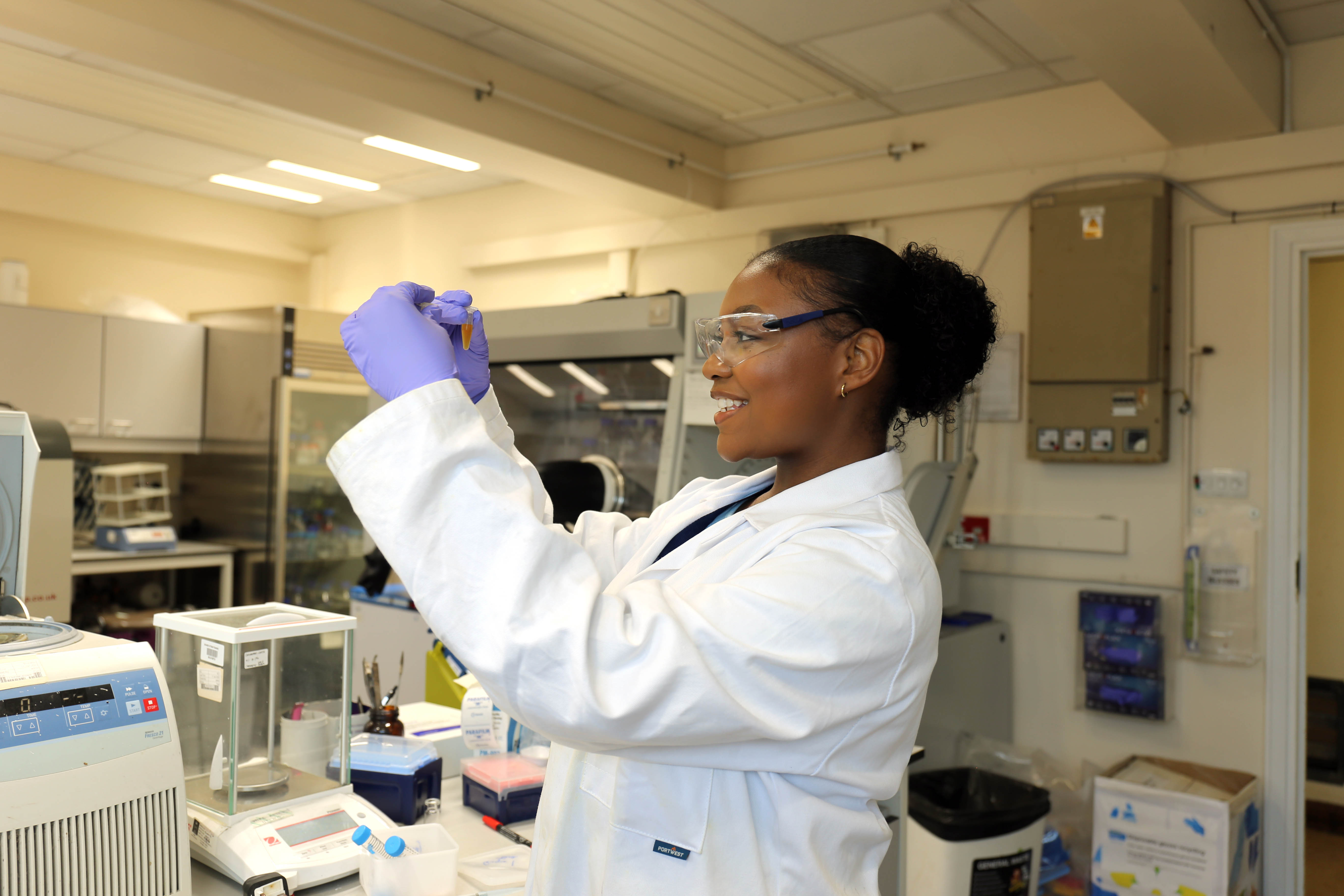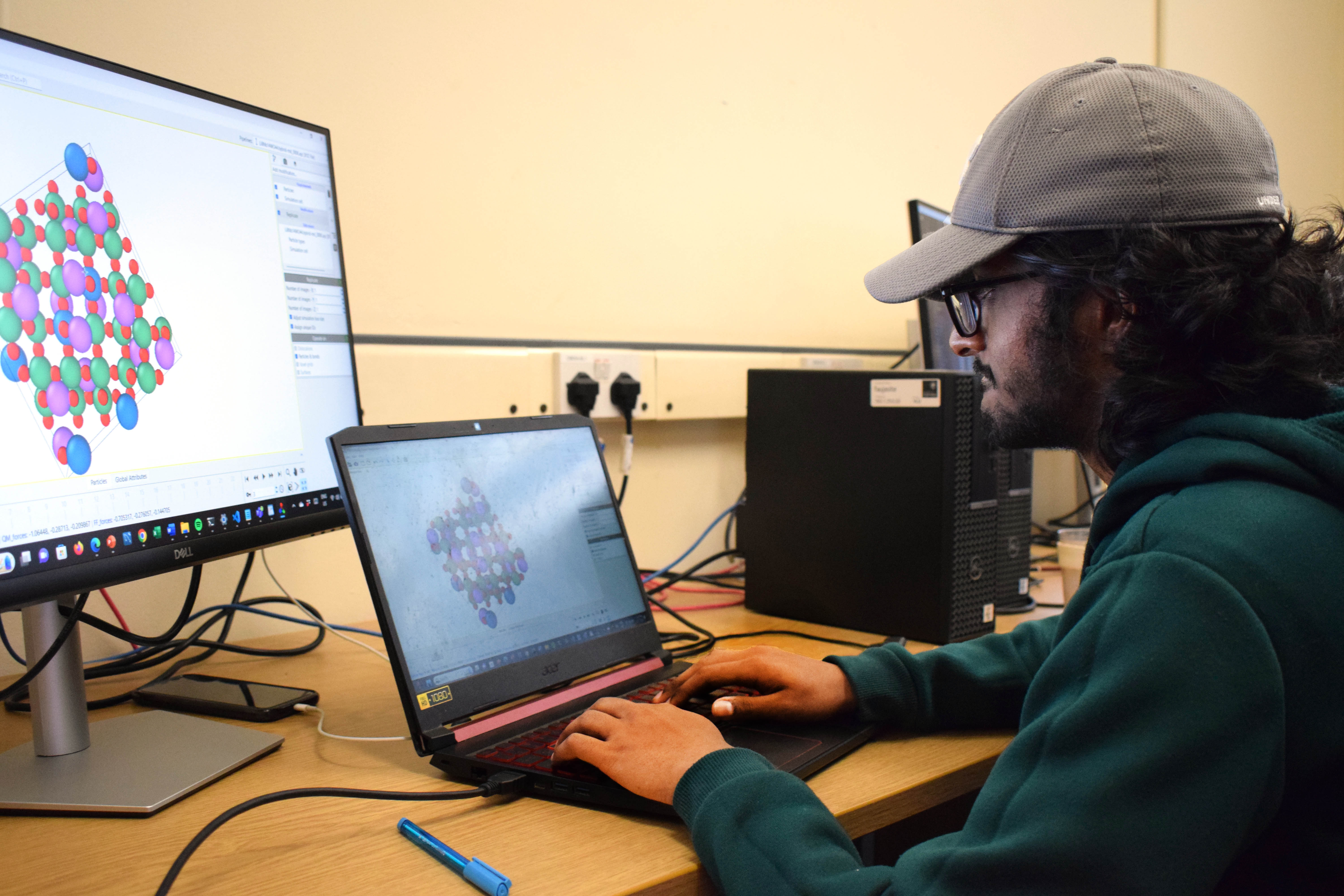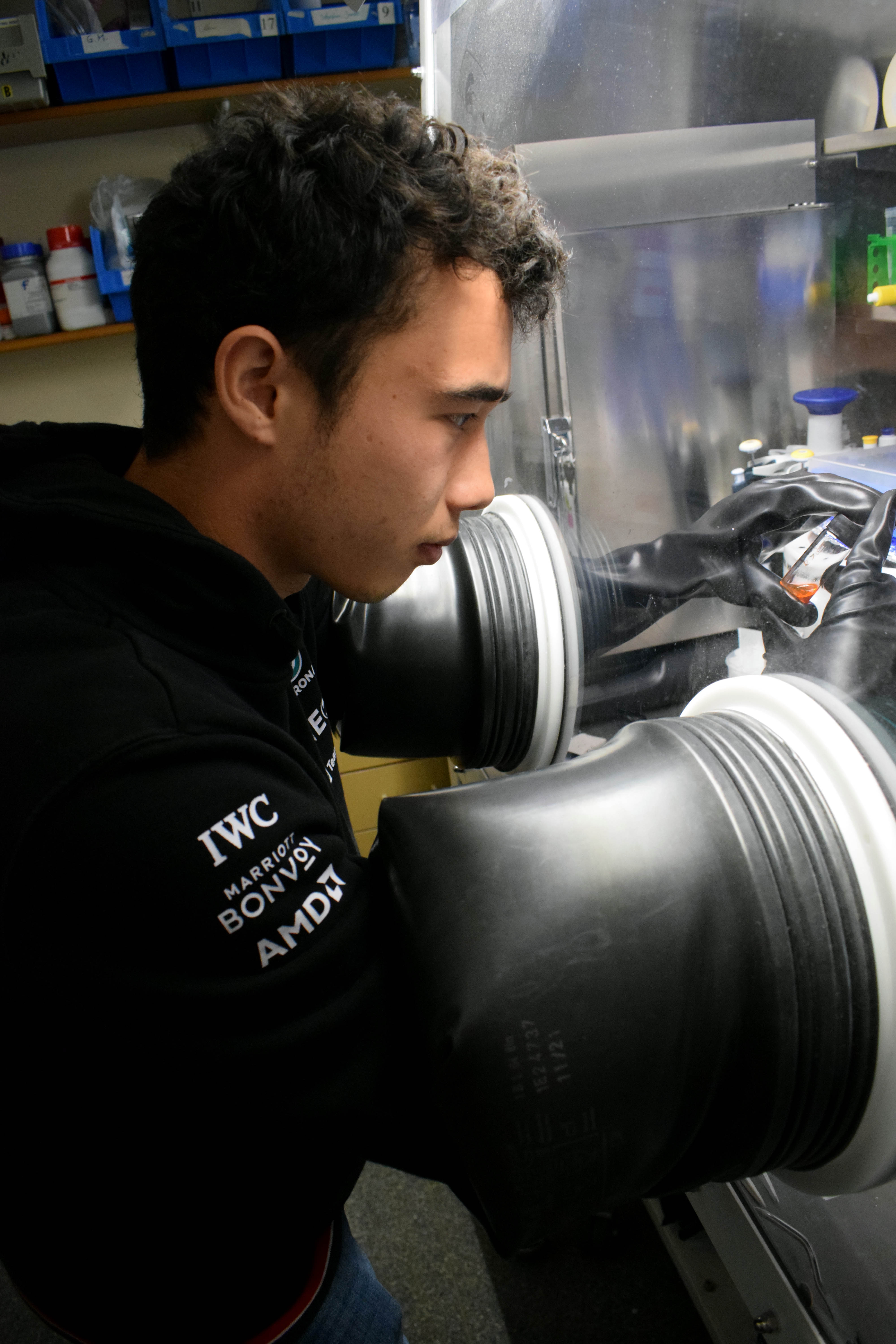Joseph Rufino Cordeiro Foundation (JRCF) Summer Research Studentships 2023
Joseph Rufino Cordeiro Foundation (JRCF) Summer Research Studentships 2023

Left to right: JRCF Trustee Melanie Crawford, Head of Chemistry Professor Steve Faulkner, JRCF student Benjamin Stewart, Chair of JRCF Board Mary Anne Cordeiro, JRCF students Nomagugu Moyo and Sivarajan Sivakumar, Head of Physical and Theoretical Chemistry and Fellow of Worcester College Professor Grant Ritchie
We are pleased to announce that the first cohort of three students, Nomagugu Moyo, Benjamin Stewart and Sivarajan Sivakumar, have completed Summer Research Studentships at the Department of Chemistry. They were sponsored by the Joseph Rufino Cordeiro Foundation. The Foundation is chaired by Mary Anne Cordeiro who is an alumnus of the Chemistry Department and Worcester College. Mary Anne’s family set up the Foundation in 2022 to honour the memory and legacy of the late Joseph Rufino Cordeiro, who was a scientist of Goan origin and educated in India.
The Foundation’s objectives include the advancement of science by providing funding for scientific research projects as well as improving scientific research capabilities among early-stage academic researchers. With these goals in mind, the Foundation’s Trustees established the JRCF Summer Research Studentships at the Department of Chemistry. The programme was designed to provide students, particularly any group that is currently under-represented in chemistry research environments, with the opportunity to pursue chemistry research at Oxford, with a current focus on sustainable chemistry.
Over the course of eight weeks this summer, the first three JRCF students completed their projects in the Department: Nomagugu Moyo, currently enrolled at the University of Southampton, worked in the Vincent group, Benjamin Stewart from the University of Oxford joined the Timmel group, and Sivarajan Sivakumar, currently studying at Edinburgh University, worked in the Deringer group.
Mary Anne said: “The Foundation is delighted by the high quality of students we have been able to attract. The Trustees were presented with ground-breaking research in three very different fields of sustainable chemistry which has reinforced for us the importance of this unique initiative with the Department of Chemistry and Worcester College. We look forward to expanding on the JRCF studentship programme in the future.”
Prof Grant Ritchie said: “It has been a pleasure for the Department to host this first cohort of summer students whose research is focussed on a diverse range of problems relating to sustainable chemistry. We are extremely grateful to the JRCF Foundation and Worcester College for partnering with us to provide these outstanding students with the opportunity to experience the research environment beyond the confines of the traditional undergraduate curriculum.”
Invitations to apply for the 2024 JRCF studentships will be sent out in spring 2024.
Each of the three JRCF students describe their summer research experience below:

Nomagugu Moyo at work in the Vincent group laboratory
Whilst there are many avenues which one could pursue within chemistry, I have personally found my passion to be sustainability. It was in my 3rd year of study, when I completed a sustainable chemistry module, that I was first acquainted with the themes of the subject. It greatly intrigued me how broad the subject can be, extending far beyond what is typically thought to be considered sustainable chemistry. Although the importance of intertwining multiple disciplines to advance research in sustainability is increasingly being highlighted, within academia the area of study is still under-represented. It was for this reason that I leaped towards the opportunity to undertake such study in the form of the Joseph Rufino Cordeiro Foundation studentship. It certainly seemed like an exciting idea to be at the frontiers of this area of science, at a prestigious university that prides itself on pioneering research.
When I was tasked with putting together a research proposal, I wondered if I could incorporate my personal interests with my knowledge of chemistry to explore uncharted areas of research. Led by my interest in textiles, I personally conducted an interview with a textile dyeing mill, to see how I could address the significant environmental concerns that are being raised with the textile manufacture industry. It became apparent to me how problematic the proliferation of azo dyes has become, disproportionately affecting those in developing countries (where the majority of global textile processing takes place).
Although there were many great groups within the Department of Chemistry at Oxford that I would have been happy to join, I was drawn towards the group of Kylie Vincent and their focus on bio-catalysis. After undertaking further research on the group’s current work, I proposed the use of a bio-catalytic method to treat textile dye wastewater. The method was simple, cost-effective and efficient, which were those important parameters to consider when looking to design a system with practical applications.
My mentors Tara Lurshay and Daria Sokolova helped me greatly to honour my research. Having them there to offer me guidance and support, created an environment in which I felt comfortable to learn in. I was not only able to build my confidence in performing lab experiments, but also my research and scientific writing skills. From the onset we had clear ambitions for the project, this helped us to accomplish so much in a short amount of time, owing to my supervisor Professor Kylie Vincent.
I feel as though I will look back on my time at Oxford fondly; an insightful experience full of pleasant memories that will last a lifetime. Living with the other two JRCF students was pivotal to my enjoyment. As well as having people to discuss work and share ideas with, I also had people to explore the city with. This is thanks to Worcester College for providing us all with accommodation.
Prior to the studentship I wasn’t entirely sure where my academic career could take me. As a black woman, it has been rare to see representations of myself within chemistry, making it difficult to picture myself pursing a PhD in the field. This experience, however, has now made the idea seem less daunting and all the more possible.

Sivarajan Sivakumar (Deringer group)
Summer was fast approaching and I was about to book my usual flight home to Malaysia when I received an intriguing email informing me about the Joseph Rufino Cordeiro Foundation (JRCF) summer studentships in sustainable chemistry. I had been interested in this field since coming to university. In particular studying materials chemistry gave me insight into the various efforts being made to design environmentally friendly alternatives to current energy storage devices. Improvement in this area will undoubtedly play a huge role as the demand for electric vehicles rises.
The most common battery used is made of lithium cobalt oxide (LCOs). Despite its relatively high specific energy, this has a number of drawbacks which include low thermal stability and high toxic waste production due to the need to nanostructure the graphite electrodes. Better alternatives to LCOs have been the topic of ongoing research. Specifically, niobium tungsten oxide (NbWO) materials caught my attention as their geometry gives them unique properties that make them more desirable than the other Li-ion based cathodes.
What drew me to Professor Deringer’s group were the efforts in applying machine learning techniques to help accelerate molecular dynamics (MD) simulations and still retain the accuracy akin to a Density Functional Theory (DFT) simulation. Like most, I was aware of machine learning (ML) but had limited experience of using it. I saw this as a great way to learn how to apply ML in my project to better understand the structure of the different phases of NbWO materials and their Li-ion diffusion pathways. This is crucial to understand to facilitate the development of more sustainable materials.
During the studentship, I was assigned a mentor, Zakariya, to help me get to grips with the fundamentals behind ML-interatomic potentials, specifically CASTEP-GAP, and apply it to the material I wanted to investigate. He was approachable and guided me to set up the infrastructure and computing environment needed to run the simulations. Before I started my project, Volker gave me a mini exercise to run a simulation of carbon atoms. The purpose was to practice running MD simulations and familiarise myself with the necessary packages. This was extremely helpful and gave me the confidence to work on my project after that. At the end of every week, I had to submit a report to Volker on the project progress which helped me keep track of my results. Volker was very encouraging and took my opinions into account during discussions as well as providing suggestions on what parameters to look for.
Overall, I was satisfied with what the group and I had achieved in modelling these materials. I gained more familiarity with using the Linux terminal and working with high performance computing. I will definitely feel more confident using computational chemistry in future projects.
I am grateful to Mary Anne and the Foundation for the excellent accommodation and catering provided at Worcester College. Living with the other JRCF students was a treat and made the experience all the more enjoyable. Our late-night chats and card games were a welcome respite. Looking forward, I am considering working in the field of computational inorganic chemistry and pursuing a PhD in this area.

Benjamin Stewart at work in the Timmel group laboratory
After two years of undergraduate chemistry, I wanted to apply my learnings to a research project, keen to begin developing a research skill set to complement the chemistry I had learned. This studentship’s focus on sustainable chemistry also interested me, and given the slow uptake of renewable energy sources, examining how chemistry could help with this issue felt like a good way to spend my summer.
The notion of solar energy has existed for centuries and in recent years has become increasingly relevant with the impending climate crisis. However, solar power constitutes a fraction of global energy production, largely due to the poor efficiency of traditional photovoltaic cells. In recent years, singlet fission materials such as organic semiconductors have shown promise in improving the efficiency of photovoltaics. My project proposed to investigate the photochemistry of one such organic semiconductor, rubrene. With the photochemical pathway being magnetically sensitive, I aimed to do this by measuring the magnetically altered photoluminescence yield in rubrene polycrystalline films. The Timmel group’s specialisation in fluorescence and magnetic field effects made it the ideal environment for such an investigation.
In addition to supervision by Prof. Christiane Timmel, I was assigned two mentors, Ana Štuhec and Dr Lewis Antill. Ana guided me through the practical components of the project by going over more advanced techniques and sample preparation, or patiently explaining the workings of the home-built experimental set-ups, which I was then able to use independently. With Lewis, my focus was to simulate the experimental data using RadicalPy, a spin dynamics toolbox that he co-created. Adapting this for singlet fission systems, we were able to simulate the data to a good degree of accuracy.
After obtaining some preliminary results, I adapted my investigations based on the data. This part of the project taught me the most about the nature of scientific research. Whilst it was frustrating at times when data defied expectations, I was able to learn from these setbacks and adapt my working hypothesis. Ultimately obtaining results that could be physically explained and reproduced by simulation was extremely rewarding. We were particularly interested in how the magnetic field effect depends on triplet exciton density, which may be significant for any photovoltaic device application. If the opportunity arises, I would like to investigate the triplet-hopping dynamics involved in singlet fission materials, with a view to simulate this experimentally observed excitation power dependence.
Outside of the lab, I was able to spend time with the other members of the studentship cohort. We were well looked after by Worcester College for the duration of the project, who provided us with meals in their hall and access to their wide-ranging facilities, including libraries, sports courts and their college bar. It was great to talk and share ideas about our individual projects but also to spend downtime exploring what Worcester and Oxford had to offer. I wish to thank the college for their fantastic hospitality.
This project has introduced me to the world of research and has inspired me to want to continue in this field into my part II year and beyond. It has been a great learning experience and I feel I have begun developing several key research skills. I wish to thank Professor Timmel and her group for welcoming me with open arms and in particular Ana and Lewis, for their patience in explaining experiments and concepts, and giving the project the perfect combination of approachability and challenge. Finally, I must of course thank Mary Anne Cordeiro and the JRC Foundation, without whom this project would not have been possible.




